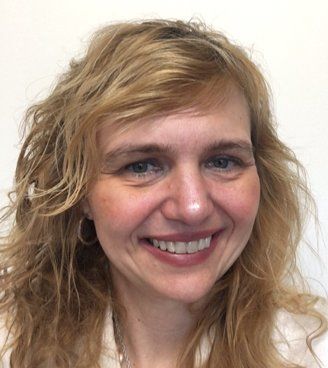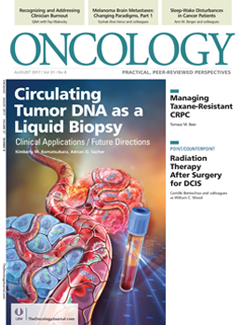Fay Hlubocky on Recognizing and Addressing Clinician Burnout
In this interview we discuss the issue of burnout in oncology, including signs and risk factors, how it might affect patient care, and strategies for prevention.
Oncology (Williston Park). 31(8):592–593, 627.

Fay Hlubocky, PhD, MA

1. How big a problem is burnout among oncologists?
DR. HLUBOCKY: Oncologist burnout is a significant issue that directly impacts patient care and the success of the organizations-such as community practices and hospitals-where oncologists work. Burnout has been identified as an occupation-related syndrome that manifests as a result of the interaction between the oncologist and the organization. It is estimated that, for over a decade, approximately 45% to 80% of practicing oncologists in the United States, Europe, and Australia have experienced core symptoms associated with burnout. Some of the variability depends on medical oncology specialty, practice, healthcare systems, and screening tools utilized; however, burnout is clearly on the rise. Our ever-evolving healthcare system, and specifically that of the oncologic specialty, is a primary contributor to this increased incidence of burnout. It is due in part to the imbalance in practice priorities and increased individual and organizational expectations in providing quality care to many seriously ill patients and their families, while being forced to devote long hours to administrative demands and documentation in the electronic medical record system. As a result, clinician wellness is adversely impacted, and feelings of emotional exhaustion and cynicism arise. Unaddressed burnout adversely impacts oncologists’ relationships with their patients, the quality of care delivered, and the long-term health of the clinician. However, sadly, for many physicians, experiencing burnout has become a stigma. In general, society has ignored physician wellness, with the belief that physicians should simply “tough it out” alone and overcome challenges. Working harder is not the antidote. Oncologists are driven by a passion, a mission to serve seriously ill patients and their family members; yet, in the face of this dedication and current demands, they tend to forget about themselves, and do not provide self-compassion and self-care.
2. When do signs of burnout typically first appear? What are those signs?
DR. HLUBOCKY: Burnout is a complex, insidious process gradually developing over an extended period of time. The signs of burnout vary. Although not well understood, for some oncologists, burnout may arise as early as during medical school and training.
Psychiatric disorders such as depression and posttraumatic stress disorders may be both precursors to the development of burnout, as well as consequences of burnout. Research has identified that residents and medical students have high rates of burnout and disproportionate rates of depression and suicide. Some of this arises from the medical training that physicians must undergo. The initial stage of burnout begins innocently, with a drive and compulsion to prove oneself to others. Yet, over time this motivation becomes eroded. After years of training as a student, intern, resident, and fellow in medical, surgical, or radiation oncology, by the time one finally assumes responsibilities as an independent clinician, one’s emotional health has already been adversely altered. The early, subtle stages of burnout then develop into the more prominent, long-lasting symptoms of physical and emotional exhaustion, cynicism and depersonalization, and low sense of professional accomplishment/feelings of ineffectiveness. These signs of burnout exist along a continuum characterized by a progression of distinctly unique symptoms, as well as an overlap of symptoms. It is a chronic process, and nearly every oncologist will experience burnout during his or her career.
3. What are the risk factors?
DR. HLUBOCKY: Multiple individual and organizational risk factors have been consistently identified as contributors to burnout in medicine. Individual contributors are internal dispositional risk factors, including sociodemographics (younger age; single or unmarried marital status; and medical trainee status). Female gender has been associated with emotional exhaustion, while male gender presents with cynicism. Positive personality characteristics such as extraversion and conscientiousness, which are important to the role of the physician, have also been recognized as risk factors. Recent evidence has demonstrated new internal contributors to burnout. Physicians who experience unaddressed burnout are less likely to identify medicine as a calling or mission of one’s life work.
However, these individual risk factors are not the sole contributors to burnout in medicine. We know that external, organizational, and/or occupational risk factors have intensified the incidence of burnout. Empirical evidence reveals that changes in healthcare delivery and the healthcare system have only contributed to the problem. Occupational stressors are those work-related factors that are at odds with the clinician’s interpretation of the job. For example, recent data suggest that for every 1-hour patient visit, a physician is tasked with 2 hours of electronic medical record responsibilities. This results in less time devoted to direct patient care. Today, more than ever, oncologists are exposed to heightened responsibilities resulting in extended work hours, decreased time in direct patient care, loss of daily control, increased administrative tasks and use of electronic health record systems, limited decision making regarding patient care, vague job expectations, poor social support, and educational debt.
Identification of all of these internal and external factors is crucial in developing both individual, and primarily organizational, oncologist wellness interventions tailored to prevent and target unaddressed burnout and to foster resilience.
4. Can clinician burnout affect patient care?
DR. HLUBOCKY: Long-term unaddressed burnout has a powerful adverse impact not only on patient care, but also on the overall oncologist-patient relationship, the quality of care delivered, and the physical and emotional health of the oncologist. Oncologists are benevolent, dedicated caregivers who tackle life-and-death decisions on a daily, if not hourly, basis with patients who are terminally ill or have serious and complex conditions, and with their family members. An oncologist experiencing burnout may believe he is effectively and appropriately addressing patients’ needs, but given the impossibility of balancing good quality care and meeting organizational demands, he falls short of meeting all demands, becoming inefficient. The oncologist trying to do more winds up accomplishing less. Consequently, the oncologist-patient relationship becomes damaged. As a result of the slow, insidious process of emotional erosion the oncologist experiences, patients may experience difficulty in effectively communicating with their oncologists, becoming less satisfied with their care.
5. What can be done to prevent or overcome burnout?
DR. HLUBOCKY: Sadly, a quick overnight solution does not exist. Burnout may be prevented, and unaddressed burnout may be resolved over time. However, it is a process and a journey. Together with support from the organization, we may simultaneously optimize oncologist wellness and enhance the cancer patient care experience. Several strategies exist: individual (eg, sleep/physical activity, mindfulness, peer support, stress management), organizational (eg, work environment change, reduction in work hours), and institutional interventions (eg, physician wellness programs) have been found to be effective. First, we must assess and identify burnout.
We must first learn to recognize the signs of burnout in oncologists. Empowering oncologists at both the individual and organizational levels with tailored strategies is key to ensuring clinician wellness. Resilience is the key protective factor against burnout; it shapes the individual’s ability to rise from adversity, re-energize, re-engage, and reassume personal responsibilities. Psychological resilience should not involve focusing on the traumatic experience of being an oncologist. Resilience places emphasis on the individual’s strength, as well as the ability to meet adversity in work and life and positively adapt to it. Resilience entails learning how to thrive and overcome the adversity oncologists face every day.
Nonetheless, this all will not happen overnight. Mastering resilience takes time and effort. Practice makes perfect. Learning to become resilient is not innate; one is not simply born with this skill, but one can learn to cultivate it over time. Individual attitudes and behavior must change. It is important for the oncologist to set boundaries, go home early when possible to recharge, and ask for help from a colleague if a break is needed during the day.
However, the individual oncologist cannot accomplish this alone. This can only be facilitated through institutional leadership identifying core areas of need. Institutional support must change and physician wellness must become key. Burnout lectures, communication skills training, and formal effective resiliency training programs must be implemented in order to mitigate the effects of stress and prevent burnout. We must foster enthusiasm, self-compassion, and efficacy.
The whole of medicine must consider adopting and developing institutional interventions, similar to those of the military or technology companies that foster wellness and resilience, enabling individuals to thrive despite present hardships. Various medical institutions, such as Stanford University and the Mayo Clinic, have multidisciplinary physician wellness programs (“WellMD” and “Physician Well-Being,” respectively) designed to improve overall physician wellness and enhance professional fulfillment by providing assistance to physicians and their families.
Financial Disclosure:The author has no significant financial interest in or other relationship with the manufacturer of any product or provider of any service mentioned in this article.
Newsletter
Stay up to date on recent advances in the multidisciplinary approach to cancer.
